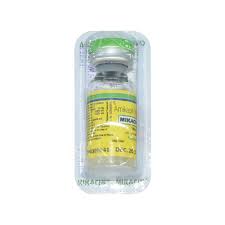Here is a complete and clear overview of:
💉 Amikacin Injection 100 mg/mL
🌿 Nature / Drug Class:
- Amikacin is a broad-spectrum aminoglycoside antibiotic
- Bactericidal – works by inhibiting bacterial protein synthesis
- Especially useful against gram-negative bacteria
- Reserved for serious infections where other antibiotics may not work
🎯 Purpose / Indications:
Used to treat moderate to severe bacterial infections, including:
- Sepsis (bloodstream infection)
- Urinary tract infections (UTIs)
- Respiratory tract infections (hospital-acquired pneumonia, etc.)
- Bone and joint infections
- Abdominal infections (peritonitis)
- Intra-hospital infections caused by resistant organisms
- Sometimes used in tuberculosis regimens (second-line)
✅ Advantages:
- Strong action against resistant gram-negative bacteria like E. coli, Klebsiella, Pseudomonas
- Rapid onset of action
- Can be used in combination therapy with other antibiotics
- Available in multiple strengths (e.g., 100 mg/mL, 250 mg/mL)
💉 Form & Administration:
- Concentration: 100 mg/mL
- Supplied in vials (commonly 2 mL = 200 mg total per vial)
- Route of administration:
- Intramuscular (IM)
- Intravenous (IV) – slow IV or infusion
- Dosing depends on:
- Body weight
- Kidney function
- Severity of infection
📦 Common Packaging:
- 2 mL glass vial containing 100 mg/mL concentration
- Hospital packs or individual units
⚠️ Patient Advice / Precautions:
- For hospital/clinical use only – needs professional administration
- Monitor kidney function and hearing during use
- Avoid if:
- Known allergy to aminoglycosides
- Severe kidney damage (unless absolutely necessary)
- Possible side effects:
- Nephrotoxicity (kidney damage – reversible if detected early)
- Ototoxicity (hearing loss or balance issues – especially with prolonged use)
- Muscle weakness (rare)
- Pain at injection site
🧊 Storage:
- Store at 2°C to 8°C (refrigerated)
- Do not freeze
- Protect from light
- Use within specified time after opening/reconstitution

